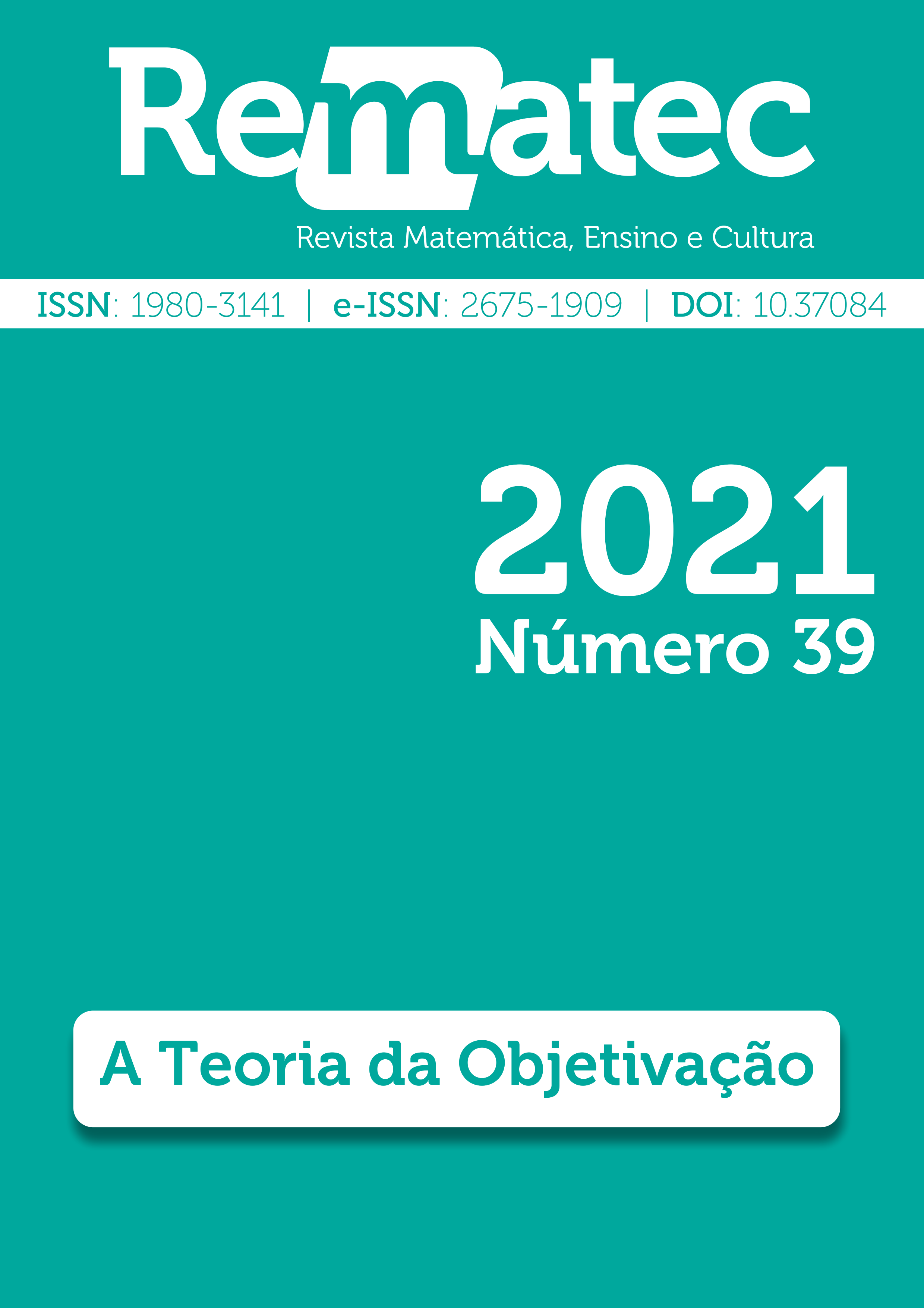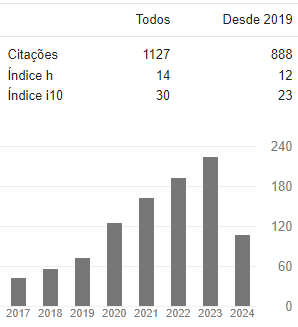Teaching and Learning of Geometry as a process of Objectification: conditions and obstacles to argumentation and proof. The role of natural language, specific language, and figures
DOI:
10.37084/REMATEC.1980-3141.2021.n39.p119-141.id487Palavras-chave:
Geometry task, natural language, use of figures in geometry, objectification, sensuous cognitionResumo
This paper examines some examples (taken from research conducted over the years) that show students’ linguistic attitudes in geometry tasks. The examples are framed within the Theory of Objectification with reference to the notion of sensuous cognition, semiotic means of objectification and levels of generality. We show the struggle students live, at higher levels of generality, in intertwining natural language, specific language and the spontaneous use of geometrical figures, bound to perception and kinaesthetic activity. Within the networking paradigm, we coordinate the Theory of Objectification and Duval’s semio-cognitive approach to frame the interplay between the ideal and the material that occurs in geometrical argumentations and proofs.
Downloads
Métricas
Referências
BALACHEFF, N. Preuve et démonstration en mathématique au collège. Recherches en Didactique des Mathématiques, v. 3, n. 3, p. 261-304, 1982.
BALDISSERRI, F.; D’AMORE, B.; FASCINELLI, E.; FIORI, M.; GASTALDELLI, B.; GOLINELLI, P. I palloncini di Greta. Atteggiamenti spontanei in situazioni di risoluzione di problemi aritmetici in età pre-scolare. Infanzia, v. 21, n. 1, p. 31-34, 1993. La Matematica e la sua didattica, v. 7, n. 4, p. 444-449, 1993. Edited also in: A. Gagatsis (ed.). Didactiché ton Mathematicòn. Thessaloniki: Erasmus. ICP93 G2011/II, 1994; in Greek: p. 239-246, in French: p. 571-578, 1994.
BARBIN, E. La dimostrazione matematica: significati epistemologici e questioni didattiche. Quaderni di lavoro n. 10. Paderno del Grappa: Istituto Filippin, 1988.
BROUSSEAU, G. Les échecs électifs en mathématiques dans l’enseignement élémentaire. Revue de Laryngologie, Otologie, Rhinologie, v. 101, n. 3-4, p. 107-131, 1980.
BROUSSEAU, G. The theory of didactical situations in mathematics. Dordrecht: Kluwer Academic Publishers, 1997.
D’AMORE, B. Esporre la matematica appresa: un problema didattico e linguistico. La matematica e la sua didattica, v. 7, n. 3, p. 289-301, 1993.
D’AMORE, B. Lingue e linguaggi nella pratica didattica. Uso spontaneo del disegno nella risoluzione di problemi di matematica nella scuola secondaria. In: B. IANNAMORELLI (ed.). Lingue e linguaggi nella pratica didattica. Atti del II Seminario Internazionale di Didattica della Matematica, Sulmona, marzo-aprile 1995. Sulmona: Qualevita. p. 79-130, 1995.
D’AMORE, B. Elementi di didattica della matematica. Preface by Colette Laborde. Bologna: Pitagora, 1999. [See also: D’AMORE, B. Didáctica de la Matemática. Prefaces by Guy Brousseau, Luis Rico Romero, Colette Laborde. Bogotá: Editorial Magisterio, 2006.]. [See also: D’AMORE, B. Elementos da Didática da Matemática. Prefaces by Guy Brousseau, Luis Rico Romero, Colette Laborde and Ubiratan D’Ambrosio. São Paulo: Livraria da Física, 2007].
D’AMORE, B. Concettualizzazione, registri di rappresentazioni semiotiche e noetica. La matematica e la sua didattica, v. 15, n. 2, p. 150-173, 2001.
D’AMORE, B. Le basi filosofiche, epistemologiche e concettuali della didattica della matematica. Preface by Guy Brousssau. Bologna: Pitagora, 2003. [See also: D’AMORE, B. Bases filosóficas, pedagógicas, epistemológicas y conceptuales de la Didáctica de la Matemática. Prefaces by Guy Brousseau and Ricardo Cantoral. México DF, México: Reverté-Relime, 2005].
D’AMORE, B. Saber, conocer, labor en didáctica de la matemática: Una contribución a la teoría de la objetivación. In: BRANCHETTI, L. (ed.). Teaching and learning mathematics: Some past and current approaches to mathematics education. Isonomia-Epistemologica: Online philosophical journal of the University of Urbino “Carlo Bo”, [Special Issue], p. 151-171. 2015. Disponível em: http://isonomia.uniurb.it/epistemologica. Acesso em: 20 fev. 2021.
D’AMORE, B. Puntualizaciones y reflexiones sobre algunos conceptos específicos y centrales en la teoría semiótico cultural de la objetivación. PNA, v. 12, n. 2, p. 97-127, 2018. DOI: https://doi.org/10.30827/pna.v12i2.6997
D’AMORE, B.; FANDIÑO PINILLA, M. I.; IORI, M. Primi elementi di semiotica. La sua presenza e la sua importanza nel processo di insegnamento- apprendimento della matematica. Prefaces by Raymond Duval and Luis Radford. Bologna: Pitagora, 2013. [See also: D’AMORE, B.; FANDIÑO PINILLA, M. I.; IORI, M. La semiotica en la didáctica de la matemática. Prefaces by Raymond Duval, Luis Radford and Carlos Vasco. Bogotá: Masgisterio, 2013.]. [See also: D’AMORE, B.; FANDIÑO PINILLA, M. I.; IORI, M. Primeiros elementos de semiótica Sua presença e sua importância no processo de ensino-aprendizagem da matemática. Prefaces by Raymond Duval, Luis Radford, Carlos Vasco and Ubiratan D’Ambrosio. Sao Paolo: Editora Livraria da Física, 2015.].
D’AMORE, B.; FANDIÑO PINILLA, M. I.; IORI, M.; MATTEUZZI, M. Análisis de los antecedentes histórico-filosóficos de la “paradoja cognitiva de Duval”. Relime, Revista Latinoamericana de Investigación en Matemática Educativa, v. 18, n. 2, p. 177-212, 2015. doi: 10.12802/relime.13.1822. Disponível em: http://www.clame.org.mx/relime.htm. Acesso em: 20 fev. 2021. DOI: https://doi.org/10.12802/relime.13.1822
D’AMORE, B.; FANDIÑO PINILLA, M. I.; MARAZZANI, I.; SARRAZY, B. Didattica della matematica: Alcuni effetti del “contratto”. Preface and postface of Guy Brousseau. Bologna: Archetipolibri, 2010. [Spanish edition: D’AMORE, B.; FANDIÑO PINILLA, M. I.; MARAZZANI, I.; SARRAZY B. El contrato didáctico, 2018.
D’AMORE, B.; SANDRI, P. Fa’ finta di essere... Indagine sull'uso della lingua comune in contesto matematico nella scuola media. L’insegnamento della matematica e delle scienze integrate, v. 19ª, n. 3, p. 223-246, 1995.
D’AMORE, B.; SANTI, G. Natural language and “mathematics languages”: Intuitive models and stereotypes in the mathematics classroom. La matematica e la sua didattica, v. 26, n. 1, p. 57-82, 2018.
DUVAL, R. Sémiosis et pensée humaine: Registres sémiotiques et apprentissages intellectuels. Berne: Peter Lang, 1995. [See also: DUVAL, R. Semiosis y pensamiento humano: Registros semióticos y aprendizajes intelectuales. Cali, Colombia: Universidad del Valle, 2004.].
DUVAL, R. Quel cognitif retenir en didactique des mathématiques? Recherche en Didactique des Mathématiques, v. 16, n. 3, p. 349-382, 1996.
DUVAL, R. Trasformazioni di rappresentazioni semiotiche e prassi di pensiero in matematica. La matematica e la sua didattica, v. 20, n. 4, p. 585–619, 2006.
DUVAL, R. Eight problems for a semiotic approach in mathematics education. In L. RADFORD, L.; SCHUBRING, G.; SEEGER. F. (ed.). Semiotics in mathematics education: Epistemology, history, classroom, and culture. Rotterdam: Sense Publishers, 2008. p. 39-61. DOI: https://doi.org/10.1163/9789087905972_004
DUVAL, R. Understanding the Mathematical Way of Thinking – The Registers of Semiotic Representations. Preface of Bruno D’Amore. Cham, Switzerland: Springer, 2017. DOI: https://doi.org/10.1007/978-3-319-56910-9
EISEMBERG, T. On the development of a sense for functions. In: G. HAVEL; E. DUBINSKI (ed.). The concept of function: Aspects of Epistemology and Pedagogy. MAA Notes, 25, p. 153-174, 1992.
ERNEST, P. () A semiotic perspective of mathematical activity: the case of number. Educational studies in mathematics, v. 61, n. 1-2, p. 67-101, 2006. DOI: https://doi.org/10.1007/s10649-006-6423-7
FANDIÑO PINILLA, M. I. Diversi aspetti che definiscono l’apprendimento e la valutazione in matematica. Bologna: Pitagora, 2020.
FISCHBEIN, E. Intuitions in science and mathematics. An educational approach. New York, Boston: Kluwer, 1987.
FISCHBEIN, E. Intuizione e dimostrazione. In: FISCHBEIN, E.; VERGNAUD, G. (ed.). Matematica a scuola: teorie ed esperienze. Bologna: Pitagora, 1992.
FISCHBEIN, E. The theory of figural concepts, Educational studies in mathematics, v. 24, n. 2, p. 139-162, 1993. DOI: https://doi.org/10.1007/BF01273689
GODINO, J. D.; BATANERO, C. Significado institucional y personal de los objetos matemáticos. Recherches en Didactique des Mathématiques, v. 14, n. 3, p. 325-355, 1994.
HUSSERL, E. Ideas: General introduction to pure phenomenology (W. R. B. Gibson, Trans.). New York: Macmillan Company, 1931. [Original work published 1913].
ILYENKOV, E. V. The concept of the ideal. In: AA. VV. (ed.). Philosophy in the USSR: Problems of Dialectical Materialism. Moscow: Progress Publishers, 1977. p. 71-99.
IORI, M. Objects, signs, and representations in the semio-cognitive analysis of the processes involved in teaching and learning mathematics: A Duvalian perspective. Educational studies in mathematics, v. 94, n. 3, p. 275-291, 2017. DOI: https://doi.org/10.1007/s10649-016-9726-3
IORI, M. Teachers’ awareness of the semio-cognitive dimension of learning mathematics. Educational studies in Mathematics, v. 98, n. 1, p. 95-113, 2018. DOI: https://doi.org/10.1007/s10649-018-9808-5
KALDRIMIDOU, M. Lo status della visualizzazione presso gli studenti e gli insegnanti di matematica. La matematica e la sua didattica, v. 9, n. 2, p. 181-194, 1995.
LABORDE, C. Langue naturelle et écriture symbolique: deux codes en interaction dans l'enseignement mathématique. Thèse, Univ. J. Fourier, Grenoble, 1982.
LABORDE, C. (). Occorre apprendere a leggere e scrivere in matematica? In: IANNAMORELLI, B. (ed.). Lingue e linguaggi nella pratica didattica. Atti del II Seminario Internazionale di Didattica della Matematica, Sulmona, marzo-aprile 1995. Sulmona: Qualevita, 1995. p. 63-78.
MAIER, H. Conflit entre langue mathématique et langue quotidienne pour les élèves. Cahiers de didactique des mathématiques, v. 11, n. 3, p. 86-118, 1993.
NARVÁEZ ORTIZ, D. Elementos para un estudio actual sobre el contrato didáctico, sus efectos y cláusulas. La matematica e la sua didattica, v. 25, n. 2, p. 181-189, 2017.
PEIRCE, C. S. Collected papers of Charles Sanders Peirce [HARTSHORNE, C.; WEISS, P.; BURKS, A. W. (eds.)]. Cambridge: Belknap Press of, 1931-1958. v. I-VIII.
PREDIGER, S., BIKNER-AHSBAHS, A., & ARZARELLO, F. Networking strategies and methods for connecting theoretical approaches: first steps towards a conceptual framework. ZDM Mathematics Education, v. 40, p. 165-178, 2008. DOI: https://doi.org/10.1007/s11858-008-0086-z
RADFORD, L. Signs and meanings in students’ emergent algebraic thinking: A semiotic analysis. Educational Studies in Mathematics, v. 42, n. 3, p. 237-268, 2000. DOI: https://doi.org/10.1023/A:1017530828058
RADFORD, L. The seen, the spoken and the written: A semiotic approach to the problem of objectification of mathematical knowledge. For the learning of mathematics, v. 22, n. 2, p. 14-23, 2002.
RADFORD, L. Gestures, speech and the sprouting of signs: A semiotic-cultural approach to students’ types of generalization. Mathematical Thinking and Learning, v. 5, n. 1, p. 37-70, 2003. DOI: https://doi.org/10.1207/S15327833MTL0501_02
RADFORD, L. La généralisation mathématique comme processus sémiotique. In: ARRIGO G. (ed.). Atti del Convegno di didattica della matematica. Locarno, Switezerland: Ed. Alta Scuola Pedagogica. 2004. p. 11-27.
RADFORD, L. The anthropology of meaning. Educational Studies in Mathematics, v. 61, n. 1-2, p. 39-65, 2006. DOI: https://doi.org/10.1007/s10649-006-7136-7
RADFORD, L. The ethics of being and knowing: Towards a cultural theory of learning. In: RADFORD, L.; SCHUBRING, G.; SEEGER, F. (ed.). Semiotics in Mathematics Education: Epistemology, History, Classroom, and Culture. Rotterdam: Sense Publishers, 2008. p. 215-234. DOI: https://doi.org/10.1163/9789087905972_013
RADFORD, L. The eye as a theoretician: Seeing structures in generalizing activities. For the learning of mathematics, v. 30, n. 2, p. 2-7, 2010.
RADFORD, L. Towards an embodied, cultural, and material conception of mathematics cognition. ZDM - The International Journal on Mathematics Education, v. 46, p. 349-361, 2014. DOI: https://doi.org/10.1007/s11858-014-0591-1
RADFORD, L. Mathematics education as a matter of labor. In: PETERS, M. A. Peters (ed.). Encyclopedia of Educational Philosophy and Theory. Section: Mathematics education philosophy and theory. (P. Valero and G. Knijnik, Editors). Singapore: Springer, 2016. DOI: 10.1007/978-981-287-532-7_518-1. Disponível em: https://www.researchgate.net/publication/309761383_Mathematics_Education_as_a_Matter_of_Labor. Acesso em: 20 fev. 2021. DOI: https://doi.org/10.1007/978-981-287-532-7_518-1
RADFORD, L. Play and the production of subjectivities in preschool. In: CARLSEN, M. ERFJORD, I.; HUNDELAND, P. S. (ed.). Mathematics education in the early years. Results from the POEM4 conference 2018. Cham: Springer, 2020. p. 43-60. DOI: https://doi.org/10.1007/978-3-030-34776-5_3
RADFORD, L.; ARZARELLO, F.; EDWARDS, L.; SABENA, C. The multimodal material mind. In: CAI, J. (ed.). First compendium for research in mathematics education. Reston, VA: NCTM, 2017. p. 700-721.
ULLMANN, S. Semántica. Introducción a la ciencia del significado. Madrid: Aguilar, 1962.
Downloads
Publicado
- Visualizações do Artigo 296
- PDF downloads: 181







 Português (Brasil)
Português (Brasil)
 Español (España)
Español (España)
 English
English






























































